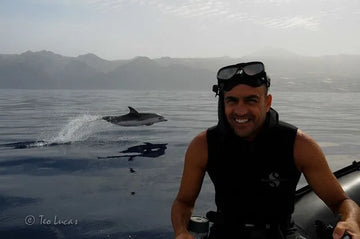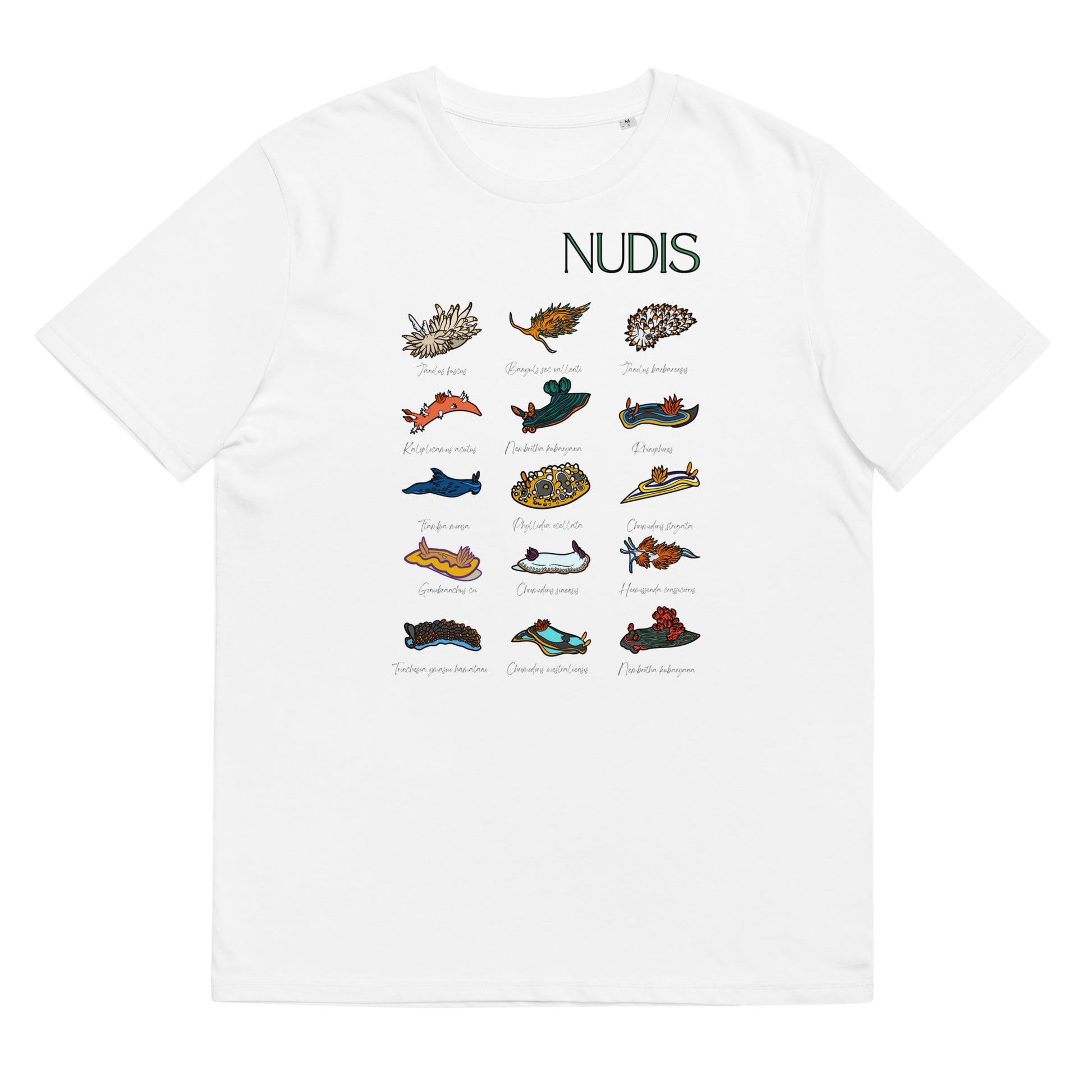The first time we heard of Francis Pérez was thanks to his picture of «La Rapadura» published by the National Geographic magazine. Those of us who regularly dive in Tenerife (Canary Islands, Spain) were amazed of a geological wonder that we never thought may have existed in the island. Then we discovered incredible images showing the beauty of creatures as feared as the Portuguese man o’ war, or schools of dolphins, smiling pilot whales, whale sharks, groups of green turtles, huge schools of mackerel surrounded by spotted dolphins or seagulls, Bryde’s whales… Thanks to Francis’ photos we found treasures that, as he has said sometime, «there is no need to go far from Europe to discover». He has revealed Tenerife’s wonders, with help from media publications worldwide and awards in competitions, to the entire planet.
T-shirts designed by divers for divers
VIEW MORE T-SHIRTS FOR DIVERS
Francis is actually an ocean lover; diving and underwater photography are just the perfect excuse to get to know it better. He always go diving with the camera but enjoying the moment, without pressure, without thinking of publishing pictures, win prizes or taking the picture of his life.

Spotted dolphins (Stenella frontalis) in Tenerife
WHEN AND HOW DID YOU START DIVING? WHAT WERE YOUR FIRST FEELINGS UNDERWATER?
I started diving in 1994, almost 20 years ago. At that time a great friend of mine, Eduardo Acevedo, convinced me to try it and now we have dived for almost 20 years together. The sensations were very good, I was amazed at that new environment. I would breath through an 18 liter tank in less than half an hour because of the euphoria I felt! Since childhood I have always been into the water so I quickly adapted to scuba diving.
HOW DID YOU GET STARTED IN UNDERWATER PHOTOGRAPHY?
Underwater photography came later, in 2001. It happened to me the same that happens to many divers, I needed something more, diving and just looking started to bore me, I wanted to take pictures, capture underwater life on a slide, show it to my friends… So I went straight into a DSLR, a Nikon F90, skipping the difficult step of the Nikonos. I had always loved photography but never had a camera as good as that one.
DID YOU RECEIVE ANY TRAINING BEFORE STARTING WITH UNDERWATER PHOTOGRAPHY?
My training was completely self-taught, asking one and all, reading and taking pictures. How difficult it was to learn at that time! I jumped into the water over the weekend, on Monday I took the film to develop, and on Tuesday I could see the pictures I took during the weekend. These past three years I have been at the School of Photography in Los Realejos (EMF) in Tenerife, I really appreciate the great support I’ve had there.
WHAT WAS YOUR FIRST PHOTOGRAPH PUBLISHED IN MEDIA ABOUT DIVING?
Well I do not know, I have not really offered myself much to the diving magazines, they have never been interested in my photographs until lately. I have published underwater pictures in magazines, books or guides but not directly related to diving. It hasn’t been until this last year when I published in the diving media industry, in magazines such as aQua, Scuba Diving, Dive Photo Guide or Submerge.
WHAT IS THE PHOTO YOU’RE MOST PROUD OF, BOTH BY THE DIFFICULTY OR ITS IMPACT?
No doubt the picture of the smalltooth sand tiger shark (Odontaspis ferox) at El Hierro is the one I am most proud of. Because of the difficulty of taking a picture of an animal as unknown as this shark is and certainly because of the impact of the picture. From my point of view, no one had really noticed the great importance of this animal. And if someone had noticed it, not much was done to know more about that animal.

I started digging a little more about this shark and sent a letter to National Geographic. They soon showed interest on it and asked me to certify my story with a marine biologist. With my photos I went to the Oceanographic Institute of the Canary Islands and there I contacted some friends. Pedro Pascual Alayón made a report and sent it to the magazine. Shortly after the Oceanographic Institute prepared a press release and got my photos even to Discovery Channel News. Shark specialists like Doug Perrine were interested on the shark, and even a marine reserve in New Zealand called me asking if I could lend the photos for their website.
WHAT DID IT MEAN FOR YOUR CAREER THAT NATIONAL GEOGRAPHIC PUBLISHED YOU FAMOUS PICTURE OF «THE RAPADURA»? DID IT CHANGE IT SOMEHOW?
After the smalltooth sand tiger sharkpicture, “La Rapadura” image represented another personal challenge that brought enormous satisfaction. Seing your photos on a world-class magazine like National Geographic does not happen every day. As it was published in the Spanish edition it got me to be more known in Spain, of course. For my career that picture represented a huge self-esteem boost, a great help to keep going on underwater photography.

LATELY WE SEE SO MANY ARTISTS LIVING IN THE CANARY ISLANDS WINNING UNDERWATER PHOTOGRAPHY COMPETITIONS AND PUBLISHING COVERS IN DIVING AND NATURE MAGAZINES. WHAT IS SO SPECIAL ABOUT THIS ISLANDS TO BE THE HOME OF SUCH GREAT UNDERWATER ARTISTS LIKE YOURSELF AND ARTURO TELLE, MONTSE GRILLO, EDUARDO ACEVEDO, JOAQUÍN GUTIÉRREZ, TEO LUCAS, RAFA HERRERO, ETC?
All great photographers, that’s for sure. Well the answer is easy, here in the Canary Islands we have water everywhere. Well, really, other than that, is that here you can dive all year long and with temperatures between 18 and 22 degree Celsius. You can almost always go diving when you feel like it. And that shows on that set of photographers. For example, why are such good surfers and windsurfers here and no skiers in the Canary Islands? That’s why…

Those you named we are all great friends and I can tell you we all dive all year long. If you do not work in a diving center but dive for yourself, you can do an average of 200 dives a year or more, that’s only possible in Europe in the Canary Islands, and results in underwater pictures. Teo, for example, has been taking pictures of whales for over 15 years, every single weekend, hence the importance of his photographic archive. That can only be done here.
WHAT ROLE DO YOU THINK UNDERWATER PHOTOGRAPHERS HAVE OR SHOULD HAVE TO PROTECT THE MARINE ECOSYSTEM?
We play a pretty important role. I think for the defense of the marine ecosystem needs us all, from the diver who discovers a species or a place, to the photographer that takes the image, the biologist, geologists, the media that shows the discovery to the people, etc.. We need to establish a channel of information that reaches the general public, and scientists cannot do that alone. We, the underwater photographers, are part of that channel, the more the merrier, the more wider channel is, the better, more transparent.
The work of a photographer is to capture the most beauty as possible, even to show the vulnerability of the marine environment, if we achieve it we will reach better to the general public. If it enters the eye it is easier to reach the heart.

WHAT THREE TIPS WOULD YOU GIVE TO PHOTOGRAPHERS WHO WANT TO MAKE A LIVING WITH UNDERWATER PHOTOGRAPHY?
First of all, find an alternative source of income. Nature photography in general is very underrated. A photographer of a Louis Vuitton campaign may charge 35,000€ for a campaign and one underwater photographer that puts himself in front of a 4-meter shark risking his life with expensive material will yield just 100€, perhaps 1,000€ if gets a cover. Today every magazine works with freelancers and when they need a photo they send an email to all their contacts and select one of the photographers, so there is a lot of hard competition.
Second, to get to be known in international media, contests are very a good way, a great showcase. And finally, travel a lot. Try to get the biggest portfolio you can.

AND FINALLY, WHAT ADVICE WOULD YOU OFFER TO DIVERS WHO WANT TO LEARN UNDERWATER PHOTOGRAPHY?
First of all, learn to dive well. You cannot concentrate on making a great underwater photo if you do not control everything and are aware of what is happening around you.
After that, buy a not very expensive camera, perhaps in the second hand market, acquire basic photography skills and start shooting everything you can, always analyzing the results and asking for advice.
The beginning is hard, do not despair, but with today’s digital cameras the learning curve is very fast, and you do not need to wait until Tuesday to see the photos (laughs). It is also important to see great underwater photography, soaking up all the books and magazines you can, see what has done before, see what it id done now, compare.























